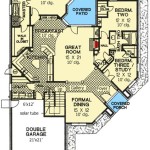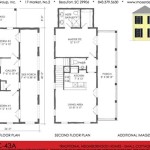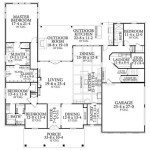Explore House Plans: Visualize Your Dream Home With Floor Plans
Embarking on the journey of building or renovating a home is a significant undertaking. It requires careful planning, meticulous execution, and a clear vision of the desired outcome. At the heart of this process lies the floor plan, a foundational document that serves as a blueprint for the entire project. A well-considered floor plan not only dictates the layout of the home but also influences its functionality, aesthetics, and overall livability. Exploring different house plans and understanding how to visualize your dream home through them is critical for a successful and satisfying outcome.
Floor plans are detailed, scaled diagrams illustrating the arrangement of rooms, walls, windows, doors, and other structural elements within a building. They provide a bird's-eye view of the home, allowing homeowners, architects, and builders to understand the spatial relationships and flow of movement within the structure. Floor plans are essential for several reasons. They facilitate communication among all parties involved in the project, ensuring everyone is on the same page regarding the design and intended outcome. They also serve as a basis for obtaining building permits, estimating construction costs, and making informed decisions about interior design and furniture placement. Finally, a well-designed floor plan can enhance the value of the property and improve the quality of life for its inhabitants.
The ability to effectively visualize a home from a floor plan is crucial, especially when dealing with abstract representations on paper. While some individuals possess a natural aptitude for spatial reasoning, others may find it challenging to translate two-dimensional drawings into a three-dimensional understanding of the proposed space. Fortunately, several tools and techniques are available to aid in visualization, enabling homeowners to actively participate in the design process and ensure their needs and preferences are adequately addressed.
Understanding the Basics of Floor Plan Reading
Deciphering a floor plan requires familiarity with common symbols, notations, and conventions used in architectural drawings. While standards may vary slightly depending on regional practices or the architect's preference, several elements remain consistent across most floor plans. A solid, thick line usually represents exterior walls, indicating a load-bearing structure. Thinner, solid lines typically denote interior walls, which may be load-bearing or non-load-bearing. Dashed lines often indicate overhead features like soffits or beams. Doors are generally represented by an arc showing the direction of swing, while windows are depicted as parallel lines within the wall thickness. Fixtures like sinks, toilets, and bathtubs are represented by standardized symbols, usually labeled for clarity. Understanding these basic elements enables a preliminary reading of the floor plan, allowing one to grasp the general layout and spatial arrangement of the rooms.
Dimensions are another critical aspect of floor plan reading. They provide precise measurements of room sizes, wall lengths, and door and window openings. Dimensions are usually expressed in feet and inches and are indicated with lines and arrows extending from the feature being measured. Understanding dimensions is crucial for determining whether furniture will fit comfortably in a room, assessing the adequacy of circulation pathways, and ensuring the overall proportions of the space are aesthetically pleasing. Pay close attention to overall dimensions, wall thicknesses, and the placement of structural elements, as these factors can significantly impact the usability and feel of the space.
Beyond the physical layout, a good floor plan also considers the orientation of the house in relation to the sun. This orientation impacts natural light, heating, and cooling needs. Notations on the floor plan should indicate the direction of North, allowing for the evaluation of sunlight exposure throughout the day. South-facing rooms will generally receive the most direct sunlight, which can be desirable in colder climates or for rooms where warmth and light are appreciated. East-facing rooms will receive morning sun, creating bright and cheerful spaces, while west-facing rooms will experience the afternoon sun, which can be intense, especially during summer months. Understanding solar orientation allows for the strategic placement of rooms to maximize natural light and minimize energy consumption.
Techniques for Visualizing Your Dream Home From a Floor Plan
Visualizing a three-dimensional space from a two-dimensional floor plan can be challenging, but several techniques can aid in this process. One simple method is to physically trace the floor plan on the ground using tape or rope. This allows you to walk through the proposed layout, experiencing the spatial relationships firsthand. You can also use furniture cutouts to simulate the placement of existing or planned furnishings, helping to assess the flow of movement and the overall feel of the space.
Another effective technique involves using design software specifically created for home visualization. These programs allow you to input the floor plan dimensions and create a virtual model of the house. You can then experiment with different color schemes, textures, and furniture arrangements, gaining a realistic sense of the finished product. Some software even allows you to take a virtual "walk-through" of the house, providing an immersive experience that aids in visualizing the space. These tools are particularly useful for identifying potential problems or design flaws before construction begins, saving time and money in the long run.
Creating a physical model of the floor plan is another hands-on approach to visualization. Using cardboard, foam board, or other readily available materials, you can build a scaled model of the house, complete with walls, windows, and doors. This tactile experience can be highly beneficial in understanding the spatial relationships and the overall form of the building. Physical models allow you to view the home from different angles and perspectives, providing a more intuitive understanding of the design than a two-dimensional drawing.
Furthermore, consider leveraging augmented reality (AR) applications. These apps enable users to overlay a virtual floor plan onto their existing environment through a smartphone or tablet. By walking through their physical space while viewing the AR overlay, users can visualize the proposed layout within their own surroundings. This provides a realistic sense of scale and allows for easy comparison of the new design with the existing space. AR technology offers a compelling way to bridge the gap between the abstract representation of a floor plan and the tangible reality of a home.
Key Considerations When Reviewing and Evaluating House Plans
When reviewing house plans, several key factors should be considered to ensure the design meets your specific needs and preferences. Functionality is paramount. The layout should facilitate comfortable and efficient living, catering to the lifestyle of the occupants. Consider the flow of movement between rooms, the placement of functional areas like the kitchen and bathrooms, and the availability of storage space. Ensure the floor plan supports your daily routines and the activities you enjoy most.
Aesthetics also play a significant role in the overall satisfaction with a home. The floor plan should create a visually appealing and harmonious space. Consider the proportions of the rooms, the placement of windows and doors, and the overall symmetry of the design. Evaluate how the floor plan integrates with the exterior architecture of the house and how it complements the surrounding landscape. A well-designed floor plan should not only be functional but also aesthetically pleasing.
Another crucial consideration is adaptability. A good floor plan should be flexible enough to accommodate future changes in your lifestyle or needs. Consider the potential for adding or removing walls, converting rooms for different purposes, or expanding the house in the future. A floor plan that can adapt to changing circumstances will ensure your home remains functional and relevant for years to come. Think about accessibility features that may become important as you age, such as wider doorways, grab bars in bathrooms, and ramps instead of stairs. Planning for the future can significantly enhance the long-term value and usability of your home.
Finally, energy efficiency is a critical aspect to consider when evaluating house plans. The floor plan should incorporate features that minimize energy consumption and reduce environmental impact. Consider the orientation of the house in relation to the sun, the placement of windows to maximize natural light and ventilation, and the use of energy-efficient materials and technologies. A well-designed floor plan can significantly reduce your carbon footprint and save money on utility bills. Elements like proper insulation, strategically placed trees for shading, and the inclusion of solar panels can contribute to a more sustainable and energy-efficient home.
By thoroughly exploring house plans and employing effective visualization techniques, homeowners can actively participate in the design process and create a home that truly reflects their needs, preferences, and aspirations. The floor plan is more than just a drawing; it is a roadmap to your dream home.

Create And Visualize House Plans In Minutes Roomsketcher

Create And Visualize House Plans In Minutes Roomsketcher

Ai Floor Plan Generator Best Interior Design Tool Online

Create And Visualize House Plans In Minutes Roomsketcher

Free Floor Plan Creator Design 2d 3d Layouts Easily

Create And Visualize House Plans In Minutes Roomsketcher

How To Read A Floor Plan With Dimensions Houseplans Blog Com

Create And Visualize House Plans In Minutes Roomsketcher

How To Draw A Floor Plan Live Home 3d

House Plans Floor Blueprints
Related Posts








